
Table of Contents
Many claim that the Hunza Valley in the Gilgit-Baltistan region of Pakistan is the true embodiment of paradise on earth. Hunza is a dazzling sight surrounded by the majestic Himalayas and Karakoram Mountains and is home to some of the most beautiful rivers, lakes, peaks, and waterfalls.
Whether the blooming apricot trees or the snow-capped Rakaposhi Peak painting a beautiful picture in the sky, the valley exudes all-around beauty. The beauty surrounding the area and its many tourist attractions make Hunza a popular destination for tourists who flock to the site yearly to witness its stunning views.
The best time to visit the Hunza Valley is from April to October when temperatures drop. The Hunza Valley can be very crowded during the summer months of June and July, with local and Chinese tourists flocking to the Hunza Valley when the temperatures are mild and warm. Use this travel guide as a reference to make the most of your stay in the valley.
Hunza Valley is considered one of the most beautiful places in Pakistan, with stunning landscapes and clear lakes. The locals are also known for being hospitable and friendly to all tourists.
Hunza Valley, commonly known as “Paradise Valley,” is a mountainous region in the Gilgit-Baltistan branch of Pakistan. It is located in the Himalayas and borders the Karakoram Mountains to the northeast.
Upper Hunza, Middle Hunza, and Lower Hunza are the three geographic subdivisions of the Hunza Valley, with Central Hunza attracting the most tourists. Karimabad, the capital of Hunza state, offers stunning views of the Rakaposhi Mountains.
Weather in the Hunza Valley can range from sweltering in summer to freezing temperatures and strong winds in winter.
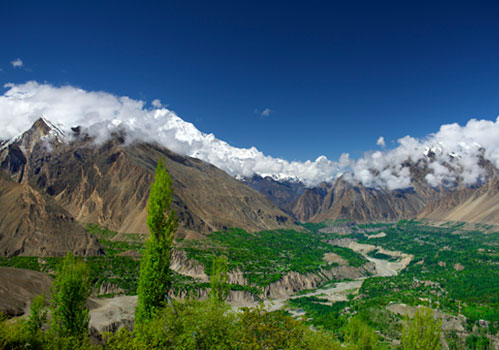
Travel Guide To Hunza Valley: Hunza Valley Weather
Due to its highest altitude of 2,438 meters, the temperature in the Hunza Valley ranges from 0 degrees in winter to 31 degrees in summer. The official tourist season runs from May to October (summer) due to road closures (due to snow).
You can choose from several ways to get to the Hunza Valley.
The first option is to fly directly to Gilgit airport and then drive a 2-3 hour flight to the Hunza Valley, which is only about 100km away. There are also many vehicle rental options.
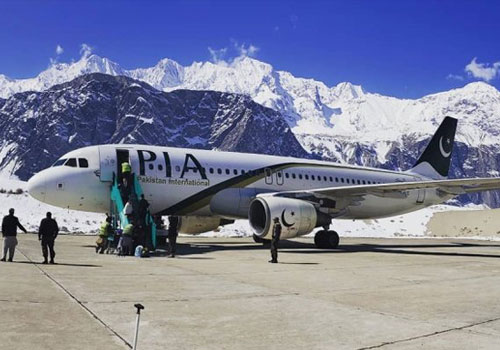
Ultimate Travel Guide To Hunza Valley: PIA flight operation to Gilgit
Pakistan International Airlines (PIA) operates daily flights between Gilgit and Islamabad; however, it is essential to note that they are often canceled or delayed due to sudden weather changes.
The most suitable option for enjoying the view is a 24-hour bus or car ride from Islamabad to the Hunza Valley. You can see the Karakoram, Skardu, and Kaghan valleys on the way.
Furthermore, Hunza has no direct transport service between Lahore and Hunza Valley. During your road trip from Islamabad to Hunza Valley, you can also plan to stay overnight in Naran, where you can visit the local market for shopping and food.
The Eagle’s Nest is among the best places in the Hunza Valley. It is a 20-minute drive from Karimabad, 6 km. It offers excellent views across the valley, especially at sunrise and sunset. A total of 11 peaks can be seen from this point. Rakaposhi, Ultar Peak, Golden Peak, Diran Peak, and Lady Finger are the most famous. The Eagle’s Nest takes its name from a nearby hotel. It has 30 well-appointed rooms, two restaurants, a lobby, and an open terrace. So if you want to stay overnight in the area, this hotel is a suitable choice.
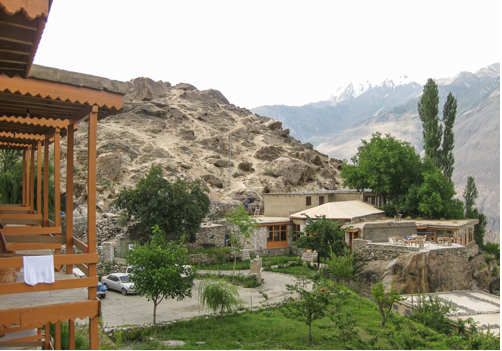
Travel Guide To Hunza Valley: Eagle Nest
Fort Baltit was built in 800 BC. It sits on top of a hill overlooking Karimabad and is one of the most picturesque places in the valley, surrounded by snow-capped mountains. You must climb a rough slope for about 15 minutes to get to Fort Baltit. Visitors can enjoy the fort’s beautiful views of Karimabad, the surrounding valley, and the Rakaposhi highlands.
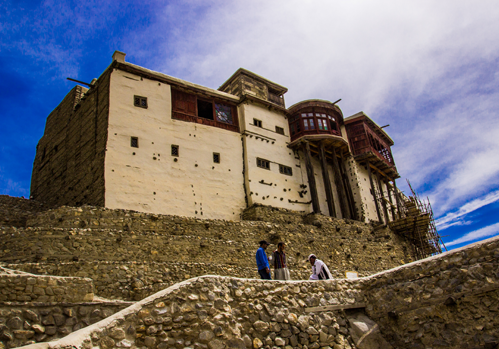
Travel Guide To Hunza Valley: Baltit Fort
Altit Fort, like Baltit Fort, is an old Hunza attraction but is not well preserved. Altit Fort and its adjacent settlements are located at the foot of the Hunza Valley and can be reached via Sultanabad Road. Originally the seat of “Hunza Mir,” it is around 900 years old and is the oldest monument in Gilgit-Baltistan.
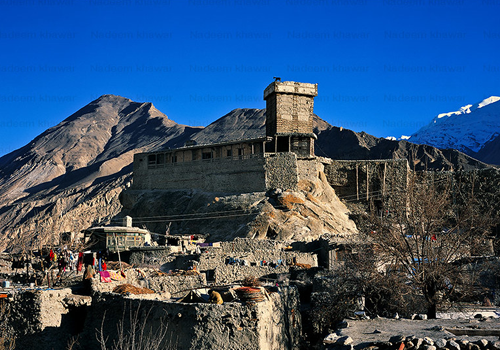
Travel Guide To Hunza Valley: Altit Fort
Another mesmerizing place in Hunza is Attabad Lake, one of Pakistan’s most visited lakes. Karimabad is 23.9 km away, and Hunza Valley is 124 km away. The lake was formed in 2010 by a massive landslide in the village of Attabad that blocked the flow of the Hunza River.
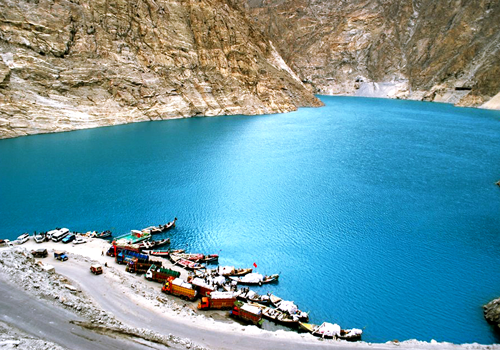
Travel Guide To Hunza Valley: Attabad Lake
It is one of the main tourist attractions in the Hunza Valley and offers a variety of activities, including boating, water skiing, fishing, and other recreational activities. Moreover, different hotels and resorts with reasonable pricing are built around this lake. If you want to stay in this beautiful place, Luxus Hunza is one of the best options for tourists and hotels in Hunza Valley.
The original Husseini Suspension Bridge was a wooden structure destroyed by floods in the early 1930s. At the beginning of the twentieth century, the authorities rebuilt it on instructions from then-President Ayub Khan. It is used to transport goods between Pakistan and Afghanistan.
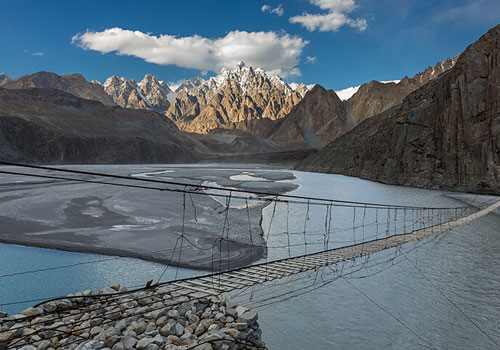
Travel Guide To Hunza Valley: Husseini Bridge
Finally, Pasu is another excellent place in the Hunza Valley. It is located along the Hunza River, about 20 kilometers from Goreme and 56.5 kilometers from Karimabad. Passu is a popular tourist destination because of its natural beauty and attractions, such as Mount Passu Sal, Mount Passu Glacier, and Mount To Popdan (also known as Paso Kunis), the highest mountain in the region at 6,106 meters above sea level. If you want to stay here, Sarai Silk Route Passu Hotel, Passu Tourist Lodge, and Passu Ambassador Hotel are the hotels you would highly rate.
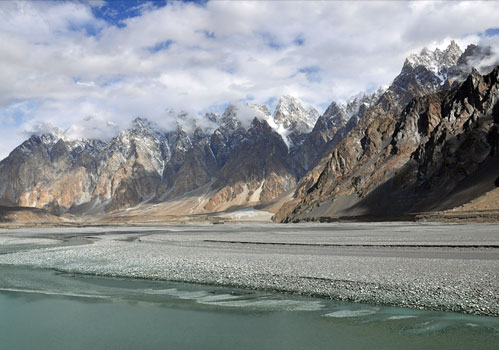
Travel Guide To Hunza Valley: Passu Cones
Pakistan has many national-level tourist attractions, among which are the traditional culture and Hunza Valley relics, which are worth visiting. It is clear from the above that the Hunza Valley is an incredible place to visit in Pakistan. The opinions, experiences, and generosity of the locals are amazing. If you plan to visit Hunza Valley, you will have a great time. However, it’s important to remember that the area is closed during the winter due to heavy snow.
The best time to visit Hunza is spring and summer. It is easily accessible (Hunza Valley is only 320 km from Islamabad), and the valley can be reached by plane or bus. It’s also relatively inexpensive, with a daily budget of around $30 for room and board. What a steal! Pack your bags, make sure your camera is fully charged, and head to Hunza Valley now.
Since 2017, Saba Ghani has been serving as the talented and dedicated chief content writer for Pakistan Tour and Travel & EMHI Solutions. With her exceptional writing skills and in-depth knowledge of the travel industry, she has been instrumental in crafting engaging and informative content that captivates the audience. You can catch her at [email protected] or Twitter
Offering Pakistan Tour And Travel plans from Islamabad , Lahore & Karachi